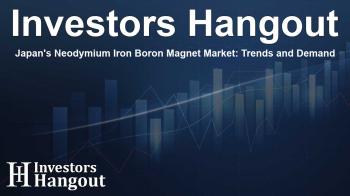Japan's Neodymium Iron Boron Magnet Market: Trends and Demand

Overview of Japan's Neodymium Iron Boron Magnet Market
As the demand for high-performance materials rises, Japan's neodymium iron boron (NdFeB) magnet market is showcasing a remarkable trajectory. With a value of US$ 992.89 million recently, the market is forecasted to expand significantly, aiming for US$ 1,211.92 million by 2033. This growth is influenced by a CAGR of 2.28% from 2025 to 2033, reflecting the increasing use of NdFeB magnets in various sectors.
The Role of Neodymium Iron Boron Magnets
Neodymium iron boron magnets are recognized for their exceptional strength and efficiency. In Japan, renowned for its technological innovations, these magnets have become indispensable across various industries like automotive, healthcare, renewable energy, and electronics. Companies such as Toyota and Panasonic leverage these powerful magnets to enhance product performance.
Significant Market Drivers
Several elements contribute to the robust demand for NdFeB magnets in Japan:
- Electrical Vehicle Advancements: The surge in electric vehicle (EV) production has played a crucial role. With Japan producing over 1.2 million EV units recently, the need for NdFeB magnets is paramount, essential for powering motors in both hybrid and fully electric vehicles.
- Renewable Energy Initiatives: Japan's commitment to carbon neutrality has bolstered the installation of wind power capacity, with neodymium magnets integral to turbine operations, ensuring efficient energy conversion.
- Consumer Electronics Growth: The need for smaller, more efficient components in devices like smartphones and laptops enhances the utilization of NdFeB magnets, solidifying their position in Japan’s tech landscape.
Market Dynamics and Innovations
Japan's reliance on rare earth elements (REEs), particularly neodymium, poses challenges and opportunities. Currently, about 85% of neodymium is imported from China, leading to vulnerabilities in the supply chain. In response, Japan has increased domestic production and recycling efforts, targeting a shift toward self-sufficiency.
Key Trends in Magnet Technology
Innovation in manufacturing processes has transformed the NdFeB magnet landscape:
- Adoption of Eco-Friendly Practices: Efforts to reduce environmental footprints in magnet production are on the rise, urging companies to invest in sustainable methodologies.
- Supply Chain Resilience: Diversifying supply chains and enhancing domestic production capabilities is crucial to mitigate geopolitical risks associated with rare earth metal sourcing.
- Technological Integration: Incorporating advanced technologies like AI in manufacturing processes is becoming standard practice, improving efficiency and product quality.
Competitive Landscape and Key Players
Several leading companies in Japan are navigating this competitive landscape:
- Proterial Ltd: Formerly Hitachi Metals, this company holds a significant share in the market, focusing on high-performance sintered magnets.
- Shin-Etsu Chemical: A critical player emphasizing purity in materials for electronics.
- TDK Corporation: Their innovative approaches in medical magnet applications keep them in the forefront.
Future Prospects and Growth Expectations
Looking ahead, the neodymium iron boron magnet market in Japan is expected to reach around 9,000 tons by 2030, driven by increased electric vehicle and renewable energy demands. Coupled with government initiatives supporting technological advancements, this sector's growth is anticipated to continue.
Frequently Asked Questions
What is the current market size of Japan's NdFeB magnets?
The market is currently valued at US$ 992.89 million and is projected to reach US$ 1,211.92 million by 2033.
How is the electric vehicle industry impacting NdFeB demand?
Electric vehicles require significant amounts of NdFeB magnets for their motors, leading to increased demand as production expands.
What role does recycling play in the supply chain?
Recycling efforts are crucial for reducing dependence on imports and making the supply chain more sustainable.
Which sectors are the largest consumers of NdFeB magnets in Japan?
The automotive and electronics industries are the primary consumers, utilizing these magnets in various applications.
What innovations are being pursued in magnet manufacturing?
Innovations include eco-friendly production methods and the integration of AI technologies to enhance efficiency.
About The Author
Contact Addison Perry privately here. Or send an email with ATTN: Addison Perry as the subject to contact@investorshangout.com.
About Investors Hangout
Investors Hangout is a leading online stock forum for financial discussion and learning, offering a wide range of free tools and resources. It draws in traders of all levels, who exchange market knowledge, investigate trading tactics, and keep an eye on industry developments in real time. Featuring financial articles, stock message boards, quotes, charts, company profiles, and live news updates. Through cooperative learning and a wealth of informational resources, it helps users from novices creating their first portfolios to experts honing their techniques. Join Investors Hangout today: https://investorshangout.com/
The content of this article is based on factual, publicly available information and does not represent legal, financial, or investment advice. Investors Hangout does not offer financial advice, and the author is not a licensed financial advisor. Consult a qualified advisor before making any financial or investment decisions based on this article. This article should not be considered advice to purchase, sell, or hold any securities or other investments. If any of the material provided here is inaccurate, please contact us for corrections.

